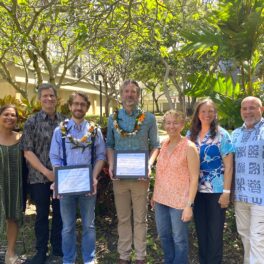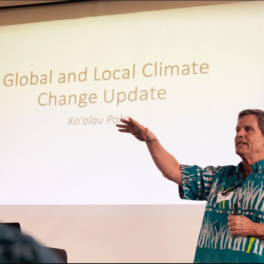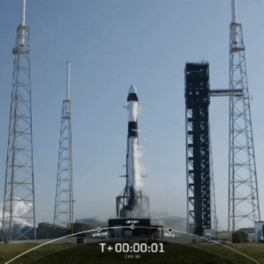New research estimates probability of Aleutian mega-earthquake
 The only well-documented paleotsunami deposit in Hawaii from the 16th century is on Kaua`i. The Makauwahi sinkhole, on the side of a hardened sand dune, is viewed toward the southeast from an apparent altitude of 342 m. Inset photos show two of the wall edges, indicating the edges of the sinkhole. The east wall (left) is 7.2 m above mean sea level, and about 100 m from the ocean. Note for scale the people in the right image. Photo credits: R. Butler (left), Gerard Fryer (right), GoogleMaps (background).
The only well-documented paleotsunami deposit in Hawaii from the 16th century is on Kaua`i. The Makauwahi sinkhole, on the side of a hardened sand dune, is viewed toward the southeast from an apparent altitude of 342 m. Inset photos show two of the wall edges, indicating the edges of the sinkhole. The east wall (left) is 7.2 m above mean sea level, and about 100 m from the ocean. Note for scale the people in the right image. Photo credits: R. Butler (left), Gerard Fryer (right), GoogleMaps (background).
A team of researchers from UH Mānoa recently published a study that estimated the probability of a Magnitude 9+ earthquake in the Aleutian Islands — an event with sufficient power to create a mega-tsunami especially threatening to Hawai‘i. In the next 50 years, they report, there is a 9% chance of such an event. An earlier State of Hawai‘i report (Table 6.12) has estimated the damage from such an event would be nearly $40 billion, with more than 300,000 people affected.
“Necessity is the mother of invention,” said Rhett Butler, lead author and geophysicist in the Hawai‘i Institute of Geophysics and Planetology (HIGP). “Having no recorded history of mega tsunamis in Hawai‘i, and given the tsunami threat to Hawai‘i, we devised a model for Magnitude 9 earthquake rates following upon the insightful work of David Burbidge and others.” Butler and co-authors Neil Frazer, professor of Geology & Geophysics (GG) and William Templeton (now at Portland State University) created a numerical model based only upon the basics of plate tectonics: fault length and plate convergence rate, handling uncertainties in the data with Bayesian techniques.
To validate this model, the researchers utilized recorded histories and seismic/tsunami evidence related to the five largest earthquakes (greater than Magnitude 9) since 1900 (Tohoku, 2011; Sumatra-Andaman, 2004; Alaska, 1964; Chile, 1960; and Kamchatka, 1952). “These five events represent half of the seismic energy that has been released globally since 1900,” said Butler. “The events differed in details, but all of them generated great tsunamis that caused enormous destruction.”
Read more about their results in the UH Mānoa News, Hawaii News Now, the Hawaii Tribune Herald, Maui Now, and the Daily Mail. UPDATE: Listen to the interview with Rhett Butler on Hawai‘i Public Radio’s The Conversation.



